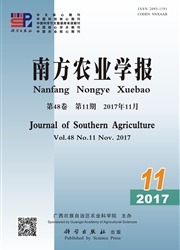

 中文摘要:
中文摘要:
【目的】检验Steedman’swax包埋切片DAPI染色法是否适用于观察花生根尖细胞核形态。【方法】分别采取100μmol/L AlCl3处理不同时间(0、4、8、12 h)后两个花生品种(铝敏感型中花2号和耐铝型99-1507)的根尖,经过Steedman’s wax包埋切片等一系列过程,利用荧光染料DAPI染色观察细胞核形态变化。【结果】100μmol/L AlCl3可引起花生根尖细胞核形态发生改变,核质浓缩、核边缘化、呈新月状等,具有明显的PCD特征。花生根尖细胞在铝胁迫下发生PCD,PCD程度与花生耐铝性呈负相关,与处理时间呈正相关。【结论】Steedman’swax包埋切片DAPI染色法是一种快速、高效的适用于观察花生根尖细胞核形态的方法。
 英文摘要:
英文摘要:
【Objective】The cell nucleus morphological changes of peanut root tip under aluminum stress were studied in order to provide scientific references for programmed cell death in peanut root tip cells induced by aluminum. And it was verified that Steedman’s wax sectioning and DAPI dyeing techniques could be used to observe nucleus morphology. 【Method】Two varieties of peanut(ZH2 Al-sensitive and 99-1507 Al-tolerant) root tips were treated with 100 μmol/L AlCl3 for different time(0, 4, 8, 12 h). Nucleus morphological changes were observed by Steedman’s wax sectioning and DAPI dyeing. 【Result】100 μmol/L AlCl3 could induce morphological changes of peanut root tip cell nucleus, such as nuclear chromatin condensation, chromatin margination and nuclear crescent shape. These were obvious characteristics of programmed cell death. PCD occurrence was negatively related to aluminum tolerance and positively correlated with the duration of treatment time in peanut. 【Conclusion】 Steedman’s wax sectioning and DAPI dyeing is a rapid and efficient method for the observation of plant nucleus morphology.
 同期刊论文项目
同期刊论文项目
 同项目期刊论文
同项目期刊论文
 期刊信息
期刊信息
